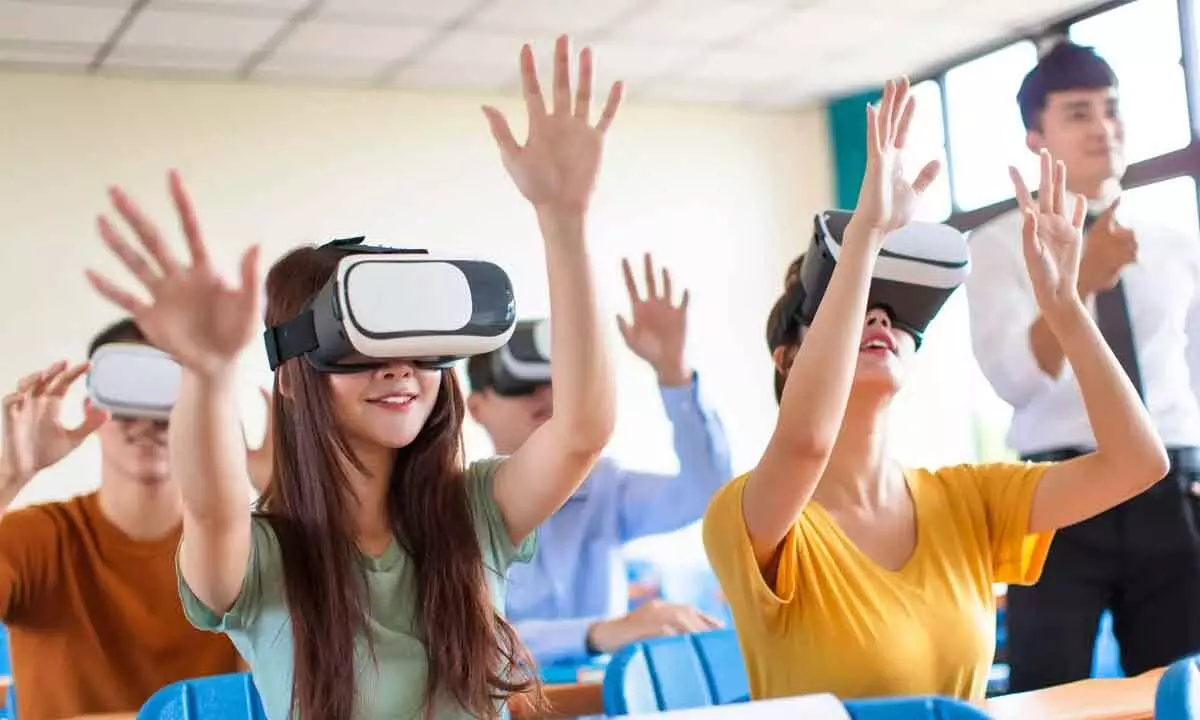Live
- Jal Jeevan Mission: Majority of Works in Kundapur Constituency Completed—Kharge
- In line with “Swarna Andhra Vision 2047,” TTD Invites Proposals on “Tirumala Vision 2047”
- High Drama at Suvarna Soudha: Heated Exchange Between Minister Lakshmi Hebbalkar and BJP Leader C.T. Ravi
- Another YouTuber behind the bars; Prasad Behera gets arrested on sexual harassment charges
- A soulful track from ‘Drinker Sai’ released
- ‘Meenu’ from ‘Sankranthiki Vasthunnam’ gains momentum
- Punjab will not allow farmers' interests to be affected, says Agriculture Minister Khudian
- US grants combined $958 million subsidy to chip maker SK hynix
- Chapter on Kashmiri Sufi saint won’t be deleted from school syllabus: CM Omar Abdullah
- Israeli school hit by missile from Yemen's Houthi group
Just In
Creating distraction-free environment for students in VR


With VR, students can explore a limitless world of knowledge, where they can engage with lessons in a way that is both interactive and more memorable
The way students learn has completely changed over time. In days past, students had to rely on memory and handwritten notes to retain information. As technology has progressed and the world has become increasingly digitized, the student attention span has taken a hit. One of the biggest challenges facing students today is the constant barrage of distractions, both inside and outside of the classroom. Gone are the days when students would sit in a quiet library and immerse themselves in dense books for hours on end.
Smartphones, access to myriad resources, and other distractions are keeping students from being fully involved in the topics they're learning. As a result, they have become accustomed to rapidly switching from task to task, constantly multitasking, and seeking instant gratification. The average attention span of a student today is shorter than that of a goldfish, which clocks in at around 9 seconds! With distractions creating a hindrance in the learning process, it is critical for institutions and educators to find ways to eliminate distractions. A technological marvel, virtual reality (VR), can be a game-changer in creating a distraction-free environment for students.
Becoming indestructible with VR
VR has eased its way into our lives and its potential impact on education is nothing short of phenomenal. Imagine stepping into a completely new world, where distractions fade away and learning becomes an immersive, interactive experience. This is exactly what virtual reality is capable of delivering to students and educators alike. Students who experience learning in VR have displayed higher scores on exams and tend to retain concepts better. Virtual reality has the potential to revolutionize the way the world learns. With VR, students can explore a limitless world of knowledge, where they can engage with lessons in a way that is both interactive and more memorable.
Immersive learning experience
A study by the University of Illinois found that VR can increase immersion and retention, with participants reporting higher levels of recall and comprehension when compared to only using traditional methods. Immersive learning experience keeps students focused on the task at hand and allows them to fully engage with the material. This can lead to better retention of information and increased engagement in learning. VR has immense potential to make classrooms more interactive and supplement traditional learning in exciting ways.
Limited hindrance
One of the most common distractions in a traditional classroom is having noisy classmates around, who can disrupt the attention of other students. In a VR environment, students can be isolated in individual virtual spaces and be fully immersed in the learning experience without any external distractions. This allows for a more effective learning experience. Not all learning should be this way, but when a student is required to tackle a cognitively challenging task, why not afford them the best opportunity to fully grasp the material at hand. This promotes greater success, learning outcomes, and confidence.
Personalised learning
A study by Deloitte found that VR increased engagement and motivation among learners, with 91% of participants reporting that they were more engaged in the material when learning in VR compared to traditional methods. Virtual reality in classrooms can provide a personalized learning experience for each student. With rich interactive content and age-appropriate activities catering to varied learning preferences, VR allows students to focus on the material that is most relevant and engaging to them.
Interactive experience
Interactive learning also allows for more creative problem-solving and critical thinking, as students are able to experiment and explore in a safe and controlled environment. For example, in a biology class, a student can take a virtual field trip to the Amazon rainforest, and observe different species of plants and animals in their natural habitats. This type of interactive learning can help students understand and retain information in a better way. Coming from an educational background, I am on a constant lookout for ways to make learning more meaningful and enjoyable. During our initiation with young learners from Sunward Park High School in South Africa, we received encouraging feedback. Those students made it very clear that using a VR headset made their learning experiences more interactive, made concepts easier to understand, and made learning fun. With its ability to immerse students in a digital world, VR eliminates distractions and can help improve focus, motivation, and learning outcomes. This approach to learning is not only more engaging, but also offers an efficient and effective way to acquire new knowledge, increase understanding, and retain concepts more readily. With VR technology constantly improving, we can expect to see even greater improvements in the learning experience of students in the near future. The time is now for educational institutions to embrace this innovative technology and solution, and provide learners with an environment that fosters creativity, productivity, and excellence.
(The author is the Chief Product Officer, Veative Group)

© 2024 Hyderabad Media House Limited/The Hans India. All rights reserved. Powered by hocalwire.com






